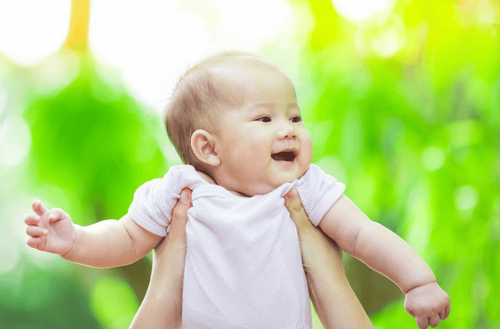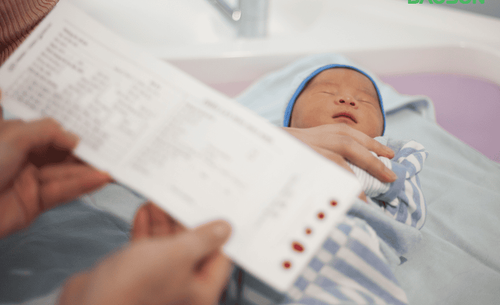This is an automatically translated article.
Neonatal jaundice is a common physiological phenomenon in children within a few days after birth. Although it can go away automatically after a while, taking care of newborn jaundice is also very important to help the healing time go faster.
1. Things to know about neonatal jaundice There are many children who experience physiological jaundice after birth, it can be 3-5 days after birth or it can also be newborn cases. 20 days old with jaundice. This phenomenon is explained by the red blood cells in the child's body breaking down, releasing a large amount of Bilirubin, which turns yellow skin, into the child's blood, preparing for the process of creating mature red blood cells. . Normally, after a period of 7-10 days, this amount of bilirubin will be eliminated from the body through urine and feces.
To detect neonatal jaundice, parents need to pay attention to observe changes in the baby's body on a regular basis. Specifically, parents need to observe the child's skin color in a place with full natural light, avoid places with artificial lights because it can cause confusion when looking. Parents can also use their hands to gently press on the child's skin and hold for a short period of time 2 - 5 seconds, for example, the skin of the chest, thighs or shins, then release the hand to observe the condition. jaundice in children. A more visible way is when the jaundice appears in easily visible places such as the face, thighs, legs and feet of the child. When the child has physiological jaundice, the child is still healthy, breastfeeding normally and has no other abnormal symptoms such as lethargy, aborting or enlarged spleen and liver.
However, there are still children with pathological jaundice, at this time the child needs to be taken to the hospital to do some tests, and the doctors will perform an examination and give treatment. suitable for children. Pathological jaundice is usually manifested by prolonged jaundice, more than 14 days in full-term infants, and more than 21 days in preterm infants. Pathological jaundice occurs at a more severe level, accompanied by a state of children refusing to feed, vomiting, irritability, even lethargy, difficulty waking or checking the child's conjunctiva will also see yellow. Serum bilirubin levels in these infants are often elevated, >12 mg/dl in term infants and >15 mg/dl in premature infants.

Cách chăm sóc trẻ sơ sinh bị vàng da được nhiều người quan tâm
2. Newborn baby with jaundice, what to do? Physiological jaundice usually resolves spontaneously after a short time. Accordingly, doctors often encourage families to take care of newborn babies with jaundice as follows:
Actively breastfeed the baby Keep the baby's body clean, especially the navel and skin areas other. Always pay attention to keep the baby warm. Do not let the child lie in a dark room for too long. It is necessary to continuously monitor the child's jaundice in a place with normal light. If there are more severe symptoms, take the child to the hospital immediately. It is recommended to practice sunbathing for children by letting them lie in places where the sun shines on.

Cho trẻ bú mẹ tích cực là cách chăm sóc trẻ sơ sinh bị vàng da
If neonatal jaundice is severe, with dark yellow skin color and other serious symptoms such as refusing to breastfeed, lasts too long, the child should be taken to the hospital for treatment such as: The following:
Phototherapy: This is one of the most popular and safe neonatal jaundice treatments available today. This method helps to convert free bilirubin into a water-soluble form, from which it is excreted more quickly. Blood exchange for children: is indicated when jaundice is too severe, spreads to the palms and feet as well as cognitive disorders. Neonatal jaundice is a very common clinical condition, although it does not directly affect the life of the child, sometimes there are severe cases of jaundice that need to be treated promptly to avoid dangerous jaundice complications. later for children.
Pediatrics Department - Vinmec International General Hospital is the address for receiving and examining diseases that babies are susceptible to, including jaundice. At Vinmec, it is equipped with a safe and easy-to-implement lighting system, babies can still breastfeed when under lights, can be combined with 10% Glucose infusion. In addition, at Vinmec, there are many types of projector lamps suitable for each jaundiced object that needs to be illuminated: Crib-shaped lights (children lie directly on top, dual lights that project above and below (used in cases where lights are needed). positive), blanket lamps, bags wrapped around the young (very convenient for mothers to take care of the baby: just pick it up to breastfeed, light up). effective or the child has late severe jaundice, has too high levels of bilirubin in the blood, the doctor will prescribe the use of blood transfusion as a last resort.
Please dial HOTLINE for more information or register for an appointment HERE. Download MyVinmec app to make appointments faster and to manage your bookings easily.













